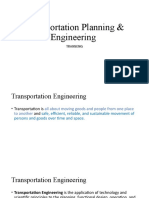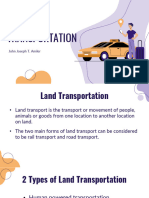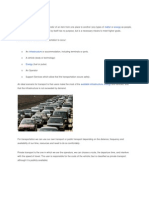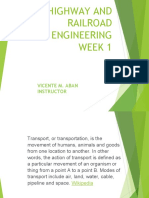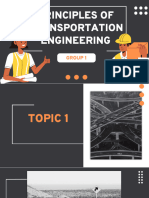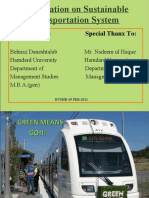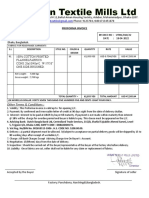0 ratings0% found this document useful (0 votes)
10 viewsLand Transportation 1
Land Transportation 1
Uploaded by
ellelelelee268Land transport involves the movement of people and goods over land using various modes of transportation. The main forms are rail transport and road transport, which can move people and freight via trains, automobiles, buses, and other vehicles. Infrastructure like roads, rail lines, and terminals connect locations and allow different modes to interchange. Vehicles provide propulsion to move along infrastructure, while public transportation makes options available for general public use.
Copyright:
© All Rights Reserved
Available Formats
Download as PPTX, PDF, TXT or read online from Scribd
Land Transportation 1
Land Transportation 1
Uploaded by
ellelelelee2680 ratings0% found this document useful (0 votes)
10 views16 pagesLand transport involves the movement of people and goods over land using various modes of transportation. The main forms are rail transport and road transport, which can move people and freight via trains, automobiles, buses, and other vehicles. Infrastructure like roads, rail lines, and terminals connect locations and allow different modes to interchange. Vehicles provide propulsion to move along infrastructure, while public transportation makes options available for general public use.
Original Title
land-transportation-1
Copyright
© © All Rights Reserved
Available Formats
PPTX, PDF, TXT or read online from Scribd
Share this document
Did you find this document useful?
Is this content inappropriate?
Land transport involves the movement of people and goods over land using various modes of transportation. The main forms are rail transport and road transport, which can move people and freight via trains, automobiles, buses, and other vehicles. Infrastructure like roads, rail lines, and terminals connect locations and allow different modes to interchange. Vehicles provide propulsion to move along infrastructure, while public transportation makes options available for general public use.
Copyright:
© All Rights Reserved
Available Formats
Download as PPTX, PDF, TXT or read online from Scribd
Download as pptx, pdf, or txt
0 ratings0% found this document useful (0 votes)
10 views16 pagesLand Transportation 1
Land Transportation 1
Uploaded by
ellelelelee268Land transport involves the movement of people and goods over land using various modes of transportation. The main forms are rail transport and road transport, which can move people and freight via trains, automobiles, buses, and other vehicles. Infrastructure like roads, rail lines, and terminals connect locations and allow different modes to interchange. Vehicles provide propulsion to move along infrastructure, while public transportation makes options available for general public use.
Copyright:
© All Rights Reserved
Available Formats
Download as PPTX, PDF, TXT or read online from Scribd
Download as pptx, pdf, or txt
You are on page 1of 16
• Land transport is the transport or movement of people,
animals or goods from one location to another location on land.
The two main forms of land transport can be considered to be
rail transport and road transport.
• Several systems of land transport have been devised, from the
most basic system of humans carrying things from place to
sophisticated networks of ground-based transportation utilising
different types of vehicles and infrastructure. The three types
are human-powered, animal powered and machine powered
• Human powered transport, a form of sustainable transportation,
is the transport of people and/or goods using human muscle-
power, in the form of walking, running and swimming. Modern
technology has allowed machines to enhance human power.
Human-powered transport remains popular for reasons of cost-
saving, leisure, physical exercise, and environmentalism;
• Animal-powered transport is the use of working animals for the
movement of people and goods. Humans may ride some of the
animals directly, use them as pack animals for carrying goods,
or harness them, alone or in teams, to pull sleds or wheeled
vehicles.
• A road is an identifiable route, way or path between two or
more places.[1] Roads are typically smoothed, paved, or
otherwise prepared to allow easy travel;[2] though they need not
be, and historically many roads were simply recognizable routes
without any formal construction or maintenance.[3] In
urban areas, roads may pass through a city or village and be
named as streets, serving a dual function as urban space
easement and route.[4]
• The most common road vehicle is the automobile; a wheeled
passenger vehicle that carries its own motor. Other users of
roads include buses, trucks, motorcycles, bicycles and
pedestrians. As of 2002, there were 590 million automobiles
worldwide.
• Rail transport is where a train runs along a set of two parallel
steel rails, known as a railway or railroad. The rails are
anchored perpendicular to ties (or sleepers) of timber, concrete
or steel, to maintain a consistent distance apart, or gauge. The
rails and perpendicular beams are placed on a foundation made
of concrete, or compressed earth and gravel in a bed of ballast.
Alternative methods include monorail and maglev.
• A train consists of one or more connected vehicles that run on
the rails. Propulsion is commonly provided by a locomotive, that
hauls a series of unpowered cars, that can carry passengers or
freight. The locomotive can be powered by steam, diesel or by
electricity supplied by trackside systems. Alternatively, some or
all the cars can be powered, known as a multiple unit. Also, a
train can be powered by horses, cables, gravity, pneumatics
and gas turbines. Railed vehicles move with much less friction
than rubber tires on paved roads, making trains more
energy efficient, though not as efficient as ships.
• Infrastructure is the fixed installations that allow a vehicle to operate.
It consists of a way, a terminal and facilities for parking and
maintenance. For rail, pipeline, road and cable transport, the entire
way the vehicle travels must be built up.
• Terminals such as stations are locations where passengers and
freight can be transferred from one vehicle or mode to another. For
passenger transport, terminals are integrating different modes to
allow riders to interchange to take advantage of each mode's
advantages. For instance, airport rail links connect airports to the city
centers and suburbs. The terminals for automobiles are parking lots,
while buses and coaches can operate from simple stops.[7]
• A vehicle is any non-living device that is used to move people
and goods. Unlike the infrastructure, the vehicle moves along
with the cargo and riders. Unless being pulled by a cable or
muscle-power, the vehicle must provide its own propulsion; this
is most commonly done through a steam engine,
combustion engine, or electric motor, though other means of
propulsion also exist. Vehicles also need a system of converting
the energy into movement; this is most commonly done
through wheels, propellers and pressure.
Public
• Public land transport refers to carriage of people and goods by
government or commercial entities which is made available to
the public at large for the purpose of facilitating the economy
and society they serve. Most transport infrastructure and large
transport vehicles are operated in this manner. Funds to pay for
such transport may come from taxes, subscriptions, direct
user fees, or some combination. The vast majority of public
transport is land-based, with commuting and postal delivery
being the primary purposes.
• Passenger transport, or travel, is divided into public and
private transport. Public transport is scheduled services on fixed
routes, while private is vehicles that provide ad hoc services at
the riders desire. The latter offers better flexibility, but has lower
capacity, and a higher environmental impact. Travel may be as
part of daily commuting, for business, leisure or migration.
• Transport is a key necessity for specialization—allowing
production and consumption of products to occur at different
locations. Transport has throughout history been a spur to
expansion; better transport allows more trade and a greater
spread of people. Economic growth has always been
dependent on increasing the capacity and rationality of
transport.[17] But the infrastructure and operation of transport
has a great impact on the land and is the largest drainer of
energy, making transport sustainability a major issue.
• Transport planning allows for high utilization and less impact
regarding new infrastructure. Using models of
transport forecasting, planners are able to predict future
transport patterns. On the operative level, logistics allows
owners of cargo to plan transport as part of the supply chain.
Transport as a field is studied through transport economics, the
backbone for the creation of regulation policy by authorities.
Transport engineering, a sub-discipline of civil engineering,
must take into account trip generation, trip distribution,
mode choice and route assignment, while the operative level is
handled through traffic engineering.
• Transport is a major use of energy and burns most of the world's
petroleum. This creates air pollution, including nitrous oxides and
particulates, and is a significant contributor to global warming
through emission of carbon dioxide,[18] for which transport is the
fastest-growing emission sector.[19] By subsector, road transport is
the largest contributor to global warming.[18]
Environmental regulations in developed countries have reduced
individual vehicles' emissions; however, this has been offset by
increases in the numbers of vehicles and in the use of each vehicle.
[18]
Some pathways to reduce the carbon emissions of road vehicles
considerably have been studied.[20][21] Energy use and emissions
vary largely between modes, causing environmentalists to call for a
transition from road to rail and human-powered transport, as well as
increased transport electrification and energy efficiency.
You might also like
- Quiz1 PDFDocument45 pagesQuiz1 PDFShami Khan Shami KhanNo ratings yet
- Scope of StudyDocument11 pagesScope of Studyalen paul50% (6)
- College of Criminal Justice TTH 3:00-4:30: Submitted By: Libres, Ralph Joseph O. BS-Crim 3Document14 pagesCollege of Criminal Justice TTH 3:00-4:30: Submitted By: Libres, Ralph Joseph O. BS-Crim 3Erien Jay Ubas OrbisoNo ratings yet
- Development of Transportation Transport or Transportation Is The Movement of People, AnimalsDocument13 pagesDevelopment of Transportation Transport or Transportation Is The Movement of People, AnimalsJohn AjishNo ratings yet
- TRANSPODocument5 pagesTRANSPODanna CagbayNo ratings yet
- Public Transportation SystemsDocument16 pagesPublic Transportation SystemsAzelma ĆatićNo ratings yet
- Development in TransportDocument5 pagesDevelopment in TransportSubramani RajaNo ratings yet
- Transportation 1Document23 pagesTransportation 1gmookambigaiNo ratings yet
- Transport:: Need For TransportationDocument28 pagesTransport:: Need For Transportationraashi bakshiNo ratings yet
- TransportDocument4 pagesTransportExtreme gaming buddyNo ratings yet
- TransportDocument12 pagesTransportNyel SaduesteNo ratings yet
- TransportationDocument12 pagesTransportationNyel SaduesteNo ratings yet
- Prelim Part 1 - SVBP 223 - IntroductionDocument53 pagesPrelim Part 1 - SVBP 223 - IntroductionRAQUISIAGA, KYNAH YVE A.No ratings yet
- TransportationDocument5 pagesTransportationAlluisa YaunNo ratings yet
- Transport or Transportation Is The Movement of People, Animals andDocument14 pagesTransport or Transportation Is The Movement of People, Animals andHarleen KaurNo ratings yet
- Use of Public Transport To Avoid Polutin: - Nisha GuptaDocument15 pagesUse of Public Transport To Avoid Polutin: - Nisha GuptaVed Khaware100% (3)
- Course Outline: Reference: CHED Memorandum Order No. 92 Series 2017Document17 pagesCourse Outline: Reference: CHED Memorandum Order No. 92 Series 2017John David RomasantaNo ratings yet
- Transportation SystemDocument6 pagesTransportation SystemMawi CrovempireNo ratings yet
- Lesson 1 CCE 2225 Transportation Planning & DevelopmentDocument32 pagesLesson 1 CCE 2225 Transportation Planning & DevelopmentDeAndre mtekoNo ratings yet
- Components of Transportation System: Mode of Transport Is A Term Used To Distinguish Substantially Different Modes ofDocument18 pagesComponents of Transportation System: Mode of Transport Is A Term Used To Distinguish Substantially Different Modes ofKamilleNo ratings yet
- Transport Engineering Chapter OneDocument13 pagesTransport Engineering Chapter Oneአድሜ ልስልሱNo ratings yet
- Module 1-1Document20 pagesModule 1-1manjunathaNo ratings yet
- Introduction To The SeminarDocument17 pagesIntroduction To The SeminarAditya BhandareNo ratings yet
- Transportation Planning & EngineeringDocument34 pagesTransportation Planning & EngineeringSenaNo ratings yet
- Transportation Engineering I 1Document47 pagesTransportation Engineering I 1Mahara KailashNo ratings yet
- Definition: Transport or Transportation Is The Movement of People andDocument94 pagesDefinition: Transport or Transportation Is The Movement of People andishaq kazeemNo ratings yet
- Transportation Types Advantages and Disadvantages InformationDocument5 pagesTransportation Types Advantages and Disadvantages InformationJasvinder SinghNo ratings yet
- 7b Land TransportationDocument16 pages7b Land TransportationJohn Joseph AmilerNo ratings yet
- I - IntroductionDocument6 pagesI - IntroductionJushien Kiel GardeNo ratings yet
- What Is Transportation: o o o o oDocument3 pagesWhat Is Transportation: o o o o oHanny HusrunNo ratings yet
- Highway and Railroad EngineeringDocument50 pagesHighway and Railroad EngineeringJessie Jade DurojaNo ratings yet
- CE120Document6 pagesCE120ronoroaNo ratings yet
- Mode of TransportDocument6 pagesMode of TransportBibithaNo ratings yet
- Group 1Document38 pagesGroup 1Arianne Rose MamelocoNo ratings yet
- HIGHWAYDocument9 pagesHIGHWAYZyra Jabon San MiguelNo ratings yet
- Transport: Transport (Commonly Used in The U.K.), or Transportation (Used in The U.S.), Is The Movement ofDocument2 pagesTransport: Transport (Commonly Used in The U.K.), or Transportation (Used in The U.S.), Is The Movement ofnatashaNo ratings yet
- Lecture 1-2 - ECE 3101Document34 pagesLecture 1-2 - ECE 3101Zaituni SuleimanNo ratings yet
- Road Engineering Assignment CDocument28 pagesRoad Engineering Assignment Cmalikarslan536No ratings yet
- Transport or Transportation Is The Movement of People, Animals andDocument1 pageTransport or Transportation Is The Movement of People, Animals andsalpanditaNo ratings yet
- 2 Components of The Transportation SystemDocument41 pages2 Components of The Transportation SystemJoshua Melegrito PeraltaNo ratings yet
- L02 Transportation Systems and OrganizationDocument26 pagesL02 Transportation Systems and OrganizationRea May De La TorreNo ratings yet
- Module 1Document30 pagesModule 1nidhi frootyNo ratings yet
- Lec 1 - Introduction Transportation EngineeringDocument33 pagesLec 1 - Introduction Transportation Engineeringkareemshdefat00No ratings yet
- Referat Transport EnglezaDocument6 pagesReferat Transport EnglezawithusernameNo ratings yet
- Moddle - 1 TEDocument25 pagesModdle - 1 TEyoganandaNo ratings yet
- Hreng 313 Reviewer TermsDocument12 pagesHreng 313 Reviewer TermsErika TolentinoNo ratings yet
- Lecture 1 - Introduction To Transportation EngineeringDocument28 pagesLecture 1 - Introduction To Transportation EngineeringRolan PaduaNo ratings yet
- Transport or Transportation Is The Movement of Humans, Animals andDocument1 pageTransport or Transportation Is The Movement of Humans, Animals andPulsar BjNo ratings yet
- Transportation Economics Module FinalDocument93 pagesTransportation Economics Module FinalNathanNo ratings yet
- Mode of TransportDocument8 pagesMode of TransportNaresh RoyalNo ratings yet
- Presentation On Sustainable Transportation System: Presented By: Special Thanx ToDocument29 pagesPresentation On Sustainable Transportation System: Presented By: Special Thanx ToBehnaz DaneshtalabNo ratings yet
- Transpo ReviewerDocument3 pagesTranspo ReviewerjermyneducusinandresNo ratings yet
- ETE 311 2023 Lecture 1 SlidesDocument10 pagesETE 311 2023 Lecture 1 SlidesTapiwa MabhandiNo ratings yet
- Moddle - 1 TEDocument25 pagesModdle - 1 TEyoganandaNo ratings yet
- Transportation Full NotesDocument154 pagesTransportation Full NotesSahana SanaNo ratings yet
- Cdi Traffic Management PrelimDocument21 pagesCdi Traffic Management PrelimPeyt Angela AnganganNo ratings yet
- Chapter OneDocument148 pagesChapter OneRamzi JamalNo ratings yet
- Chapter 1Document13 pagesChapter 1Andenet AshagrieNo ratings yet
- CE 3213 - First AssignmentDocument9 pagesCE 3213 - First AssignmentJulrey Angelo SedenoNo ratings yet
- Transport of India Geo Project 2024-25Document33 pagesTransport of India Geo Project 2024-25ursanne14No ratings yet
- Unit 5 2023tsvDocument35 pagesUnit 5 2023tsvqmir27No ratings yet
- The Future of Transportation: Innovations in Mobility and SustainabilityFrom EverandThe Future of Transportation: Innovations in Mobility and SustainabilityRating: 1 out of 5 stars1/5 (1)
- Gold Star Pi 18 - 04 - 2022Document2 pagesGold Star Pi 18 - 04 - 2022Mohammad TahmeedNo ratings yet
- Akhil Jain Arth Vyas Kingshuk Bangabash Prasanna NarayananDocument14 pagesAkhil Jain Arth Vyas Kingshuk Bangabash Prasanna NarayananPrasanna NarayananNo ratings yet
- Introducing BMW 360º.: Guarantee The Future With A Plan That Covers It AllDocument3 pagesIntroducing BMW 360º.: Guarantee The Future With A Plan That Covers It Allgarvitgoyal31No ratings yet
- Ch-1 (B) Cost Concepts, Classificaions and TermsDocument51 pagesCh-1 (B) Cost Concepts, Classificaions and TermsGirma NageoNo ratings yet
- Improving Performance of Store Management: A Case Study of Dhaka Electric Supply Company Ltd. (DESCO)Document97 pagesImproving Performance of Store Management: A Case Study of Dhaka Electric Supply Company Ltd. (DESCO)Sarello AssenavNo ratings yet
- Section 400 418Document7 pagesSection 400 418Macy Andrade100% (1)
- Basics of Cost AccountingDocument21 pagesBasics of Cost AccountingRose DallyNo ratings yet
- 2ND SEM ENTREPRENEURSHIP 4th GRADINGDocument13 pages2ND SEM ENTREPRENEURSHIP 4th GRADINGAnne Clarette MaligayaNo ratings yet
- ASF AgendaDocument23 pagesASF Agendaank333No ratings yet
- Xibo Signage Order 89173Document2 pagesXibo Signage Order 89173marcuv89No ratings yet
- Revenue Policy v1 - 1660736081Document3 pagesRevenue Policy v1 - 1660736081Essaar EnterprisesNo ratings yet
- Assignment ScheduleDocument1 pageAssignment ScheduleRaja RajanNo ratings yet
- China Poverty AlleviationDocument13 pagesChina Poverty AlleviationNadia RafiqNo ratings yet
- Annual Report 2018Document112 pagesAnnual Report 2018Time to ShareNo ratings yet
- White Hats Strategic OverviewDocument4 pagesWhite Hats Strategic OverviewTheWhiteHats100% (1)
- Precise Software Solutions: Group No:-6Document19 pagesPrecise Software Solutions: Group No:-6Dushyant PandaNo ratings yet
- 02 Global Initiatives of Sustainability in Development and Business-20221109080801Document68 pages02 Global Initiatives of Sustainability in Development and Business-20221109080801BAGES AZANDA PUTRA 111202095No ratings yet
- Company Profile - (Eng) 日通インドネシア物流 会社案内 Pt Nx Lemo Indonesia LogistikDocument10 pagesCompany Profile - (Eng) 日通インドネシア物流 会社案内 Pt Nx Lemo Indonesia LogistikJka SugiartoNo ratings yet
- FA1 Chapter 5 EngDocument9 pagesFA1 Chapter 5 EngNicola PoonNo ratings yet
- Scholarworks - On The Decomposition of Wage DifferentialsDocument9 pagesScholarworks - On The Decomposition of Wage DifferentialsRirin HidayatiNo ratings yet
- SAP FICO Master Data NotesDocument34 pagesSAP FICO Master Data NotesSoru SaxenaNo ratings yet
- Financial Activities of Rastriya Banijya Bank Limited: An Internship ReportDocument45 pagesFinancial Activities of Rastriya Banijya Bank Limited: An Internship ReportPrajwol Thapa100% (1)
- Shriram Finanace NewDocument43 pagesShriram Finanace NewRavi GuptaNo ratings yet
- Save The Kids White PaperDocument8 pagesSave The Kids White PapergonekatNo ratings yet
- Annual Report: ISO 9001:2015 "To Do It Right and Best From The Beginning"Document204 pagesAnnual Report: ISO 9001:2015 "To Do It Right and Best From The Beginning"Santhiya MogenNo ratings yet
- The Expenditure Cycle Part II: Payroll Processing and Fixed Asset ProceduresDocument33 pagesThe Expenditure Cycle Part II: Payroll Processing and Fixed Asset ProceduresontykerlsNo ratings yet
- CBD Section ManagerDocument3 pagesCBD Section ManagerYatendra VarmaNo ratings yet
- Waste Disposal Narrative ReportDocument9 pagesWaste Disposal Narrative ReportGilmar ManzanoNo ratings yet























